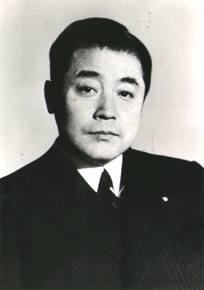Keizō Shibusawa | |
|---|---|
 | |
| Minister of Finance of Japan | |
| In office 9 October 1945 – 22 May 1946 | |
| Prime Minister | Kijūrō Shidehara |
| Preceded by | Juichi Tsushima |
| Succeeded by | Tanzan Ishibashi |
| 16th Governor of the Bank of Japan | |
| In office 18 March 1944 – 9 October 1945 | |
| Prime Minister | Hideki Tojo Kuniaki Koiso Kantaro Suzuki Naruhiko Higashikuni |
| Preceded by | Toyotarō Yūki |
| Succeeded by | Eikichi Araki |
| Personal details | |
| Born | August 25, 1896 Tokyo, Japan |
| Died | October 25, 1963 (aged 67) |
| Alma mater | Tokyo Imperial University |
Viscount Keizō Shibusawa (渋沢 敬三, Shibusawa Keizō, August 25, 1896 – October 25, 1963) was a Japanese businessman, central banker, philanthropist and folklorist. He was the 16th governor of the Bank of Japan (BOJ).
Early life
[edit]Shibusawa was born in Tokyo.[1] He was the grandson of Shibusawa Eiichi.[2]
Career
[edit]Shibusawa was governor of the Bank of Japan from March 18, 1944 – October 9, 1945.[3] He left the bank to serve as Finance Minister in the brief post-war government of Kijūrō Shidehara in 1945-1946.[4]
The dissolution of the Japanese zaibatsu was implemented during the period in which he was head of the Ministry of Finance.[2]
Shibusawa was involved in the creation of the core collection of the National Museum of Ethnology in Osaka.[5]
See also
[edit]Notes
[edit]- ^ Bank of Japan (BOJ), 16th Governor
- ^ a b Tamaki, Norio. (1995). Japanese Banking: a History, 1859-1959, p. 187, p. 187, at Google Books
- ^ BOJ, List of Governors; Werner, Richard A. (2003). Princes of the Yen: Japan's Central Bankers and the Transformation of the Economy, p. 147, p. 147, at Google Books
- ^ "Major Posts Filled in Jap Cabinet; Shaping Into Conservative Body," The Argus (Australia). 9 October 1945, p. 1; retrieved 2011-08-21
- ^ Izumi Koide. "Mining for Information Gold: How to get at it?" p. 2, Association for Asian Studies (AAS) conference, April 2, 2005; retrieved 2011-08-22
References
[edit]- Tamaki, Norio. (1995). Japanese Banking: a History, 1859-1959. Cambridge: Cambridge University Press. ISBN 9780521496766; OCLC 231677071
- Werner, Richard A. (2003). Princes of the Yen: Japan's Central Bankers and the Transformation of the Economy. Armonk, New York: M.E. Sharpe. ISBN 978-0-7656-1048-5; OCLC 471605161